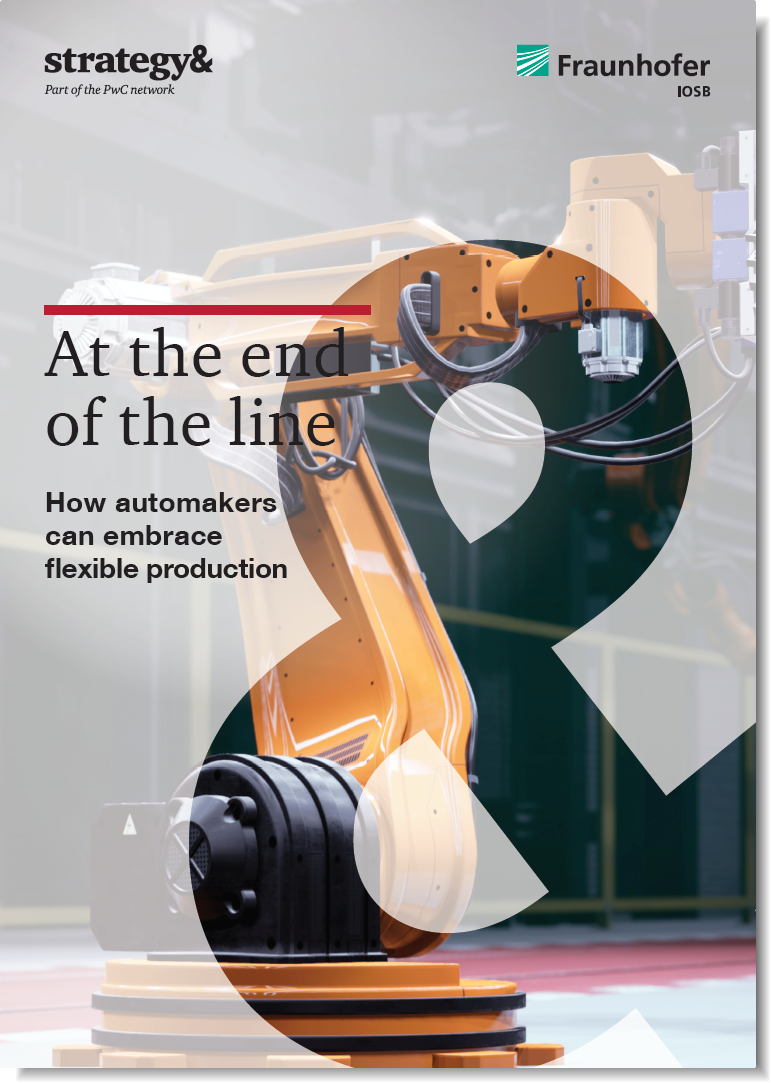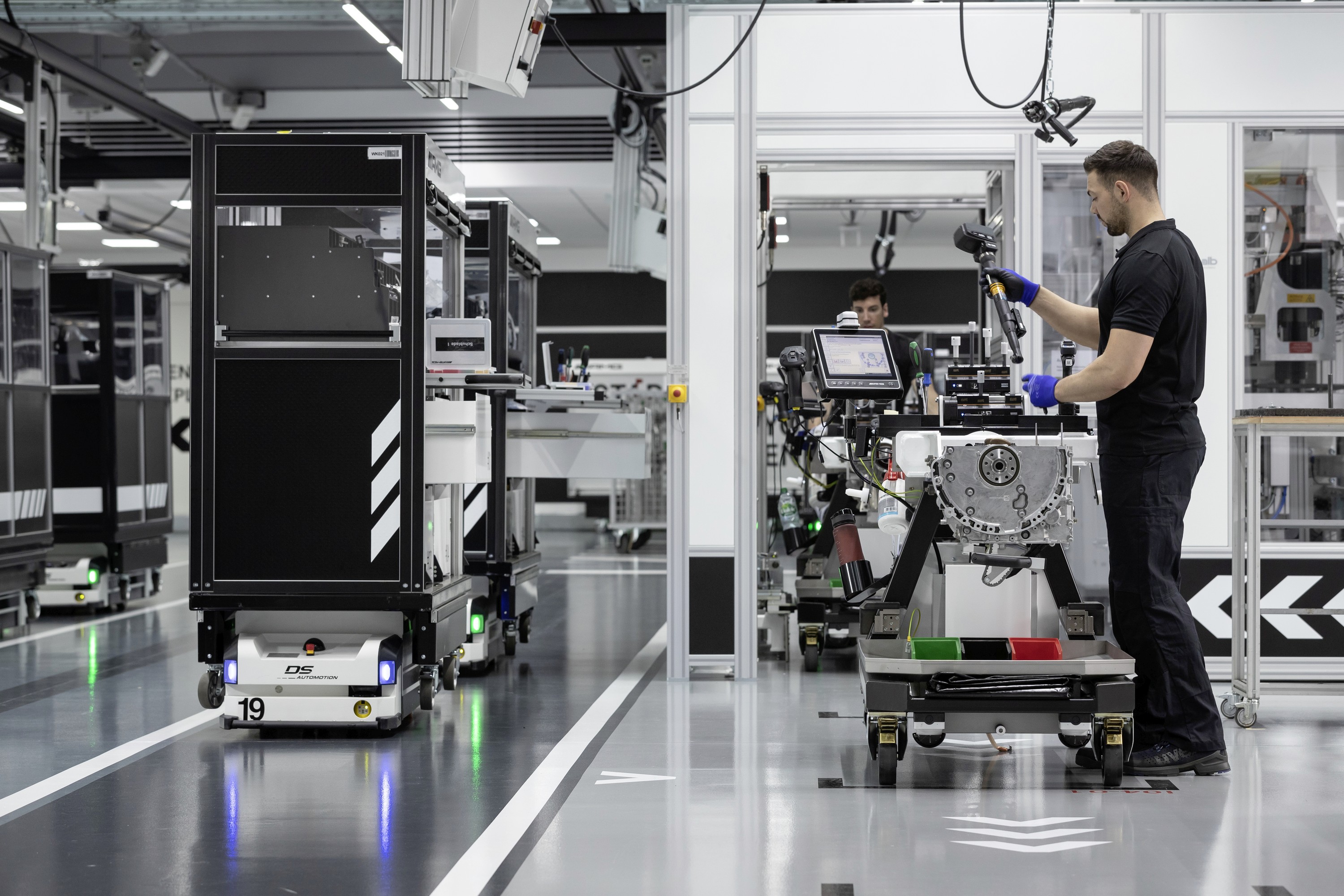Self-organizing, flexible production instead of assembly line: Study on the car factory of the future published
How can automotive production remain competitive in times of ever greater diversity of variants and ever faster product cycles? The new study "At the end of the line - How automakers can embrace flexible production" [1] sees the solution, at least for the premium segment, in intelligently networked, self-organizing production. This means rethinking the pearl chain principle established today. The effort could pay for itself within a very short time, as the study authors from Strategy& Deutschland, the strategy consultancy of PwC, and the Fraunhofer Institute of Optronics, System Technologies and Image Exploitation IOSB write.


Moving autonomously, even before they are finished: Cars are navigating through the factory on a driverless transport system instead of on the assembly line, on an individually optimized course between the modular, versatile and fully networked machines and systems. Behind this, instead of human planning and control, is digitized, AI-driven self-organization that is not limited to the factory floor but extends across the entire supply chain. This is the vision that the study now published paints for the future production of cars that compete for the favor of individual buyers - as opposed to the production of volume models that are used for car sharing, for example.
Pearl chain principle reaches its limits
"The idea of self-organizing production can already be found in the first documents on Industrie 4.0 - and even then it was not new," explains Dr.-Ing. Olaf Sauer, one of the authors of the study. In 2013, for example, acatech described in its "Implementation Recommendations for the Future Project Industry 4.0" the vision that "intelligent products (...) are capable (of) steering themselves independently through production due to their ad hoc networking capability as well as by carrying a digital product description".
Today, the state of the art in body construction, painting and assembly is the control principle of the pearl chain, consistently implemented up to "just-in-sequence" delivery: The components arrive in exactly the right sequence for the vehicles or pearls to be produced. "However, the increasing diversity of vehicle types, variants and derivatives is pushing the pearl chain principle to its limits," explains Sauer, who coordinates the Automation and Digitalization business unit at Fraunhofer IOSB. "For example, the actual work content and effort of a particular processing step can vary greatly from vehicle to vehicle - yet a uniform average cycle time must apply to all of them."
Promising implementation examples of self-organizing production
The required versatility is also difficult to implement within this framework. The standard today is automated operating equipment designed for specific series, engine variants or assembly scopes. "Such equipment is very efficient when utilization is high - but if demand fluctuates, as it is now during the Corona crisis, fixed costs become a problem," Sauer said. What is needed for cost-effective production under these circumstances, he says, are more flexible plants, more universally applicable operating equipment and modularized production that can be converted for new tasks without high engineering costs.
"Of course, this is demanding to implement - but it is possible with today's state of the art and economically worthwhile, as demonstrated by a number of examples that we take a closer look at in the study," says Sauer. The challenges include permanent localization and online tracking of the car bodies, components and means of transport, as well as simulation and operational control of the entire system. Methods such as reinforcement learning and scalable edge cloud data centers (GAIA-X nodes directly on the production floor) provide the appropriate tools.
For customers from the manufacturing industry, Fraunhofer IOSB conducts case studies on the introduction of self-organized production and logistics. Furthermore, algorithms for distributed planning are specifically developed and evaluated in simulation environments.
Flexible and resilient supply chains
However, self-organization does not only take place in the factory, but can also help at the level of global supply chains. "Suppliers are reluctant to hand over planning authority and thus confidential information to a central supply chain orchestrator," explains Olaf Sauer. Self-organization and agent-based decentralized planning open up a way out of the dilemma.
With the Smart Factory Web [2], which has been declared an official testbed by the Industrial Internet Consortium, Fraunhofer IOSB has therefore developed a marketplace for the flexible utilization of production capacities available worldwide. This marketplace is linked to a detailed description model for existing production capabilities and allows concrete production processes to be monitored online. At the same time, the Smart Factory Web meets the highest standards of data security and sovereignty.
"Self-organization in a network of production sites and suppliers, however, will require systematic use of artificial intelligence and machine learning methods," says Dr. Julius Pfrommer, research group leader at Fraunhofer IOSB and another author of the study. That includes learning models generated across companies ("federated learning"), he adds. "However, to make AI methods a well-manageable tool for planning and development engineers, there is still a certain gap to be bridged in practice." Fraunhofer IOSB is addressing this challenge together with the Karlsruhe Institute of Technology (KIT) and the FZI Research Center for Information Technology in the new Karlsruhe Competence Center for AI Engineering (CC-KING) [3]. Funded by the Ministry of Economics of Baden-Württemberg, methodological fundamentals, tools and demonstration scenarios for AI engineering are to be pushed forward here, and consulting services and training courses for industry and SMEs are to be offered.
1] The study "At the end of the line - How automakers can embrace flexible production" by Strategy& Deutschland and Fraunhofer IOSB is now available and can be downloaded free of charge here.
Last modified:
 Fraunhofer Institute of Optronics, System Technologies and Image Exploitation IOSB
Fraunhofer Institute of Optronics, System Technologies and Image Exploitation IOSB